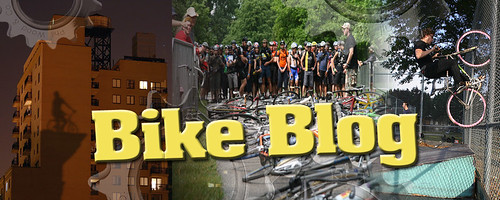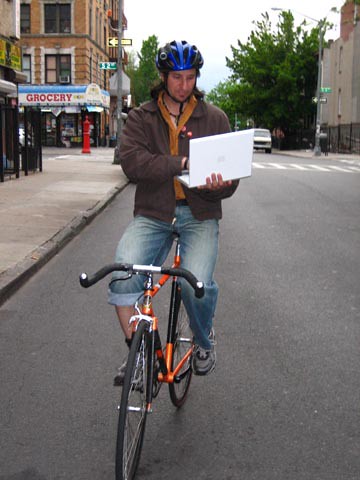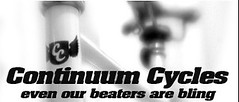Article on Cycling in NYC
The Tao of Cycling
by Amy Landau
New York HopeDance correspondent Ms. Landau gives us a fascinating report of her experience with biking in NYC, the Critical Mass rides, the clown bikers who patrol bike lanes, Times Up! and Transportation Alternatives that give diversity and life to the prevalent auto-centric culture.
“Hey, I’m bikin’ here! I’m bikin’ here!”
Those words could have been the immortal words of Dustin Hoffman’s Ratso Rizzo in “Midnight Cowboy,” as he smacked that car while crossing the street, had he been a NYC cyclist, rather than a pedestrian. I too, have wanted to smack the hood of every car that put my life in danger while navigating the maze of NYC streets on bike.
Let me back up and say that when I first returned to the cluttered, noisy chaos of NYC, it was the bicycle that saved me. It brought me that delicious sense of freedom, space and power that I craved amidst the frantic combat zone of daily city life. And it also got me from point A to point B without having to wait underground on a dirty subway platform.
I remember the magic of my first bike ride over the bejeweled Brooklyn Bridge at night, an experience which rendered me speechless. The whole city seemed to be laid out just for me through a majestic archway with water gleaming hypnotically below, city skyscrapers dazzling above in a parade of electric color. It was like falling in love with the city all over again. As I whizzed by with the cool air blowing through my hair, my companion remarked that she felt “so sad for people who don’t ride bikes in New York.” Indeed, the bicycle showed me NY in a way I’d never experienced it before: it connected me to the city’s terrain, its actual landscape. And from that moment on, I believed that the bike was virtually the key to New York as it was meant to be experienced.
But now I have reached a latter stage as a NYC cyclist: cynicism has set in, tempering my enthusiasm. It’s not easy to commute by bike through aggressive NYC traffic on a regular basis. I don’t enjoy having to fend for my life first thing in the morning. I don’t like losing my temper and having to shout, “Fuck you!” to strangers at the top of my lungs. Let’s just say, it shatters my equanimity -- which is not a nice thing to happen first thing in the morning.
In addition, I am up against an entire system that seems intent on frustrating me as well as other cyclists and pedestrians. Ever since the 2004 Republican National Convention, the NYPD has repeatedly sought to squelch Critical Mass (the monthly group bike ride that asserts cyclists’ right to the road) and the rights of protestors, in general, through nasty tactics of arrest, ticketing and sometimes violence. After a few failed attempts, the NYPD finally succeeded in establishing “Parade Permit” rules. These rules require that groups of 50 – whether on foot, bicycle, or other “devices moved by human power” – apply for a permit before they can march on any street or roadway. A permit means that an established route must be approved by police ahead of time. Such rules fly in the face of the entire concept of Critical Mass, which is meant to be a spontaneous group ride with no established leader or route. Can you imagine such a requirement for the thousands of cars that jam the roadway? In addition, the city is now considering new restrictions on commercial pedicabs (bicycle-cabs), which would greatly diminish the “safety in numbers” affect of cycling in the city. The issue of cyclists’ right to the road is such a hot topic in NY right now that an editorial in the New York Times spoke out on the subject, objecting to the initial Parade Permit rules and calling for greater safety measures for cyclists. A less-sympathetic article appeared in the New Yorker, titled “Holy Rollers: The City’s Bicycle Zealots.”
New York City itself is a city of contradictions, and perhaps it comes as no surprise that territory would be a constant source of debate here, from real estate to the road itself. On the one hand, NY is, unquestionably, the ideal city for alternative transportation. We are already one of the few cities in the United States with such a developed public transportation system that we can claim the “A” train as one of the longest subway lines in the world (running more than 31 miles, from northern Manhattan to Far Rockaway, Queens). The terrain of the city is also relatively flat and easy to navigate, making it ideal for biking. To some degree, the Department of Transportation (DOT) has even begun to recognize the value of cycling to the city’s well-being – the agency recently announced a plan to add 200 more miles of bike lanes! And this is the ultimate in walk-able cities, right?
Well, not so fast. We are also a city absurdly dominated by the needs of the automobile, from the inside-out. Our city officials, stuck in a 1950s time warp (think: Robert Moses), not only insist on driving, but view their driving privileges as carte blanche for committing routine violations that endanger the public. What’s more, even though only 14% of New Yorkers drive personal vehicles through the central business district (midtown), a mistaken belief prevails that NY’s economy depends on the automobile. According to the Partnership for NYC, just the opposite is true: over $13 billion a year gets lost every year due to traffic congestion, and this is merely a conservative estimate, not the toll on the economy in human lives or road repair, for example. Thus, New York, for all its cutting-edge persona, trails behind other modern cities like London, Paris and Copenhagen, who have all addressed their traffic problems through traffic-calming measures such as congestion-pricing, rapid bus-only lanes and divided bike lanes. These cities recognized that traffic harmed not only the city’s quality of life (air and noise pollution/lack of space for walking and biking) but also placed a tremendous burden on its economy.
So what’s the good news for NY? I have begun to realize that the contradictions are what make this city so ripe and juicy with possibility. NY has reached that crucial time of change, a crossroads of unprecedented significance for both its future as a livable city and a financial center. I know of two admirable agents of change that are helping to steer NY into the 21st century: “Time’s Up!,” a grassroots cycling/environmental advocacy group and Transportation Alternatives (TA), a more mainstream catalyst for improving NYC’s transportation. Both groups blow me away with the intensity of their dedication and imagination. They work toward change in different, yet equally powerful ways, sometimes joining forces, but always retaining distinct identities.
Times Up!, “NYC’s direct-action environmental group” is a radical-minded organization purely made up of volunteers with tentacles that spin out in vastly creative ways, embracing group bike rides, cycling awareness, street art, community gardening, public education and more. This group is on the edgy, renegade side, participating in Critical Masses which assert cyclists’ rights to the road, engaging in civil disobedience but also raising person-to-person awareness of cycling safety issues. I think of them as “the people.” I have participated in their group bike rides, clown bike-lane liberation brigade (you dress up like a clown and pass out “tickets” to errant motorists parked in the bike lane) and most notably the 2007 Cyclist Memorial Ride (commemorating cyclist deaths by cars) which they helped organize. By their own account, two of their greatest achievements for 2006 were their increase in public programming and participation and the positive press attention they have received. They were named the “Best Activist Organization on Two Wheels” by the Village Voice. Time’s Up! also helped start the flourishing commercial pedicab business here which has grown to nearly 500 strong [see page 36 for more photographs that relate to this story].
On the other hand, Transportation Alternatives (TA), “the Advocates for Bicycling, Walking and Sensible Transportation,” is made up of young Ivy-leaguers who wear suits and are versed in city politics and diplomacy. They do all the homework to back up their proposals to the city: exhaustive quality-of-life studies (“Do neighbors talk to each other on streets with heavy traffic?”) and more. They invite city planners like Jan Gehl from Copenhagen to speak in NY, help produce innovative films like “Contested Streets,” [stay tuned for the review in next issue as well as the screening of the film during the Bike Film Festival in both SB and SLO] and make proposals to the DOT and the mayor for traffic-calming measures, etc. Their influence as a respected voice of change is mirrored in their regular mention in the New York Times. I have participated in their “Car-free Central Park” rallies, attended their panels and helped distribute outreach flyers for their committees in my community. Among their achievements has been the securing of pedestrian and bicycling paths on all East River bridges (for the first time in 50 years) and a complete 10-mile-long Hudson River greenway (car-free pedestrian/bike path).
In terms of city infrastructure, the latest, breaking news is that sinister Chief Bruce Smolka of the NYPD (the borough commander of midtown Manhattan) and long-time nemesis of Critical Mass, has stepped down, much to the jubilation of cyclists and civil rights activists everywhere. Add to this that the DOT commissioner of six years (Iris Weinshall) has just resigned, and you might begin to see why I can picture a more cyclist-friendly NYC on the horizon. Most of all, it’s the dynamic work of Time’s Up! and TA that encourage me to believe that NY has indeed entered a fertile time of change for the better. The fact is: we have backed ourselves into a corner with all our cars and traffic. There is literally no place to move but forward, and I don’t mean with a car!
When I look at NYC with all its contradictions, I’m reminded of the yin/yang symbol of Taoist tradition that shows us light is dependent on dark, positive dependent on negative. I am reminded of the Chinese artist, Lily Yeh who said that the most desperate, negative conditions she faced only excited her with the greatest promise for their opposite (the prospect of building a park in a vacant city lot). And that’s exactly the force I see in NYC’s future.
Time’s Up!: http://times-up.org/
Transportation Alternatives:
http://www.transalt.org/
Partnership for NYC Report: http://www.nycp.org/publications/Growth%20or%20Gridlock.pdf
Warrior Angel: The Work of Lillian Yeh: http://www.barefootartists.org/Lilys_Warrior_Angel_11_2.pdf
Amy Landau is HopeDance’s “New York City correspondent.” She is a writer and environmental educator living in Harlem and working in the South Bronx. Contact her at lapislion@yahoo.com.











1 Comments:
.
We all have to wonder what Bloomberg is really thinking of with this congestion pricing tax scheme. Maybe he mostly just wants a new tax. Just wrap it up in ‘concern for the environment’, and then people can just demonize those who oppose it.
If he cares so much about traffic jams, congestion and air pollution, why does he let Park Avenue be blocked off? Why doesn’t he do anything about that?
It's true, Pershing Square Restaurant blocks Park Avenue going South at 42nd St. for about 12 hours a day/5 months of the year! This Causes Massive Congestion & Air Pollution!
But apparently it does not bother NYC’s Nanny-in-Chief Mike “Congestion Pricing Tax” Bloomberg? Check out the map!
http://whataplanet.blogspot.com
http://preview.tinyurl.com/38obfd
Check it out!
Thanks,
Little Blue PD
:)
Post a Comment
<< Home